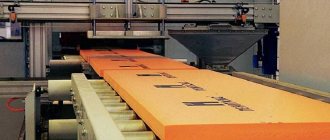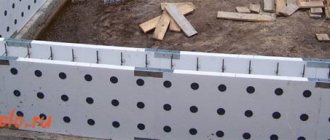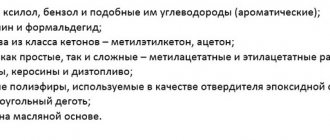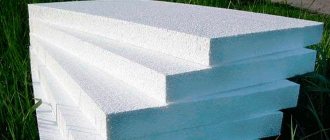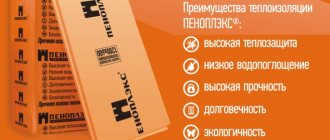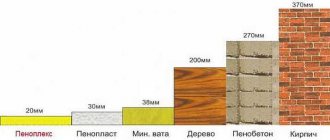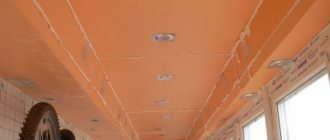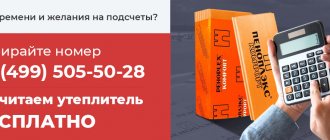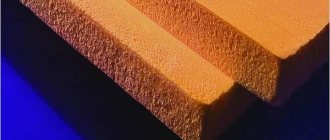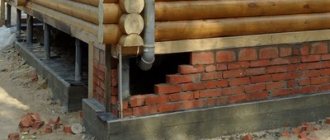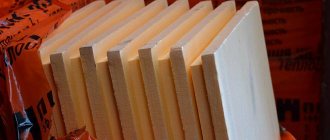The main differences between Penoplex insulation Base and Foundation
Several years ago I expanded my product line. Such brands of insulation as Osnova, Facade, Pitched Roof, GEO, Foundation appeared on the market. What is the difference between Penoplex Base and Foundation, and what differences do other types have?
The characteristic features of each type are their size, level of thermal conductivity, water absorption and vapor permeability. According to these indicators, the Base and Comfort are similar, the only difference being the compressive strength.
The insulation materials Foundation and GEO are similar in their parameters. These types are intended for use under high loads, and therefore have increased compressive strength.
Specifications
Penoplex is a porous material, it is foamed polystyrene, which is also hidden under the abbreviations EPS and XPS. In its structure it has microcells filled with air. The cells are very tiny, up to 0.2 mm. The surface of the material is smooth, orange in color. Penoplex packaging is a special protective film that protects the material from ultraviolet radiation.
Penoplex does not react with soil or building materials
One Penoplex Comfort slab has quite impressive dimensions. The length of the material is 120 cm, width - 60 cm. Thickness can vary from 20 to 100 mm. By the way, the thickest option allows you to increase the strength of the entire structure by increasing its strength characteristics.
On a note! The quality of the material is strictly controlled by the manufacturer, and the insulation also undergoes certain tests to ensure compliance with all requirements in special accredited laboratories.
Insulation Penoplex Foundation (corresponds to the old type Penoplex 35 without fire retardant)
Table. Main characteristics of Penoplex .
| Index | Value, units change |
| Thermal conductivity (coefficient) | 0.03 W/(m×°C) |
| Density | Up to 35 kg/m3 |
| Vapor permeability | 0.013 Mg/(m*h*Pa). |
| Safe Temperature Range | -50-+75 degrees |
| Compressive strength with linear deformation | 0.15 MPa |
Penoplex belongs to flammability class 4. As for thermal conductivity, at the moment the material has the best indicator of this value among all existing insulation materials. In addition, the indicator does not depend on any external factors, including the level of humidity or temperature.
Balcony insulation
Attention! When purchasing Penoplex, it is important to make sure that the material has a special certificate of conformity. It contains all the characteristics of the insulation. If the document is not available, then buying such material risks the fact that you can buy a fake for quite a lot of money.
Since the density of Penoplex is very high, it practically does not absorb moisture. So the material is recommended for use in rooms with high humidity.
Penoplex Foundation
It is a polystyrene slab made by extrusion. The foamed mass passes through the molding nozzles by pressing. At the outlet, under the influence of high pressure and temperature, a porous structure containing cells with air is formed.
Main characteristics of Penoplex Foundation:
- Density 29-33 kg/m3
- Sound absorption – 41 dB
- Moisture absorption – about 0.5%
- Fire resistance – group G4
- Vapor permeability – 0.007-0.008
- Temperature range – 100 – +75c
- Compressive strength – 0.27 MPa
Pros of Penoplex Foundation:
- Low water absorption
- Protection of the foundation from groundwater and melt water
- Increased strength
- Resistance to heavy loads, including soil pressure
- High sound insulation
- Not susceptible to mold or rotting
- Frost resistance
- Easy to install and cut
- The ability to carry out insulation work in any weather outside
- Long service life.
Minuses:
- Smokiness during fire formation
- The destructive influence of direct sunlight and a number of solvents.
Penoplex Foundation is one of the most durable types of insulation of this brand. It creates a reliable and warm foundation, basements, and prevents swelling under the influence of frost. Its service life exceeds 50 years.
Video: Properties and characteristics of Penoplex
Penoplex Base is expanded polystyrene slabs produced using extrusion technology. It consists of forcing the foamed molten mass through molding nozzles.
As a result, under the influence of temperature and high pressure, the material acquires a finely porous structure with small air cells isolated from each other.
The standard width of the foam base sheet is 600 mm, and the length is 1200 mm. Sheet thickness can be 20, 30, 40, 50, 60, 80, 100, 120 or 150 mm.
Penoplex Base
This building material has a wider range of applications. It is also made from polystyrene by extrusion.
The insulation has excellent characteristics: light weight, low density, which makes the structure light and easy to install. The compressive strength is quite high - 0.12-0.22 MPa. By deciding to buy Penoplex Basis, you will save a lot on heating.
Pros:
- Excellent thermal insulation due to a special cellular structure
- Operation even in severe weather
- Evaporation resistance – high vapor permeability
- Moisture resistance (can also be used for insulating saunas and baths)
- High strength
- Service life more than 50 years
- Easy to install
- Light weight.
Minuses:
- The material is obtained artificially
- Smoke in case of fire.
Penoplex Base forms a light, strong and durable layer of thermal insulation, reliably protects against adverse factors and ensures a comfortable temperature in the house at any time of the year.
It is used for insulating walls, floors, pitched roofs, that is, on those structures that are not subject to high loads.
Let's consider other types of Penoplex
Comfort
It has found wide application in insulating basement floors, walls, balconies, greenhouses, livestock farms, utilities, and pitched roofs. Not applicable to structures with high loads.
Designed to create a thermal insulation layer for foundations, roofs, floors, and these objects can have a high load.
Roof
It is used to insulate roofs of all types, and also provides warmth in parking lots.
Facade
This type of Penoplex is in high demand for insulating surfaces from the inside and outside: facades, partitions. The main feature is good adhesion of plaster and glue to its surface.
Penoplex 45
This insulation is applicable for those structures that are subject to increased requirements. We are talking about the construction of runways at airfields, roads and the like.
offers a wide selection of Penoplex at affordable prices with delivery to Tyumen. Call now!
Source
Penoplex Comfort - for mansions, balconies and saunas
This material (formerly called PENOPLEX 31C) is universal. If you want, insulate a country cottage or dacha with it, or a loggia or balcony. For thermal insulation of a private home, this insulation is simply ideal. They can cover the floor, foundation, basement, roof and walls. If you have a swimming pool, sauna or bathhouse, then PENOPLEX®COMFORT is also suitable for thermal insulation of their walls, as it can withstand high humidity well. It is a kind of universal insulation of this brand.
| Options | Unit measurements | Values |
| Thermal conductivity coefficient at (25±5) °C | W/(m×°K) | 0,03 |
| Density | kg/m³ | 25,0-35,0 |
| Compressive strength at 10% linear deformation, not less | MPa (kgf/cm2; t/m2) | 0,20 (2,0; 20) |
| Water absorption in 28 days | % by volume | 0,5 |
| Fire resistance category | group | G4 |
| Operating temperature range | °C | -50 . +75 |
| Standard sizes, width/length/thickness | mm | 600/1200/20; 30; 40; 50; 60; 80; 100 |
What is the difference between penoplex comfort and foundation?
Penoplex is produced on the basis of extrusion, which gives the material a high thermal conductivity (0.03 W*m*0C) and reliability. The fine-porous structure has evenly spaced cells measuring only 0.1 to 0.2 mm. This gives strength that foam cannot boast. The product is produced in the form of plates. It is easy to handle and install. Even an inexperienced builder can cope. Research and testing have shown that the degree of moisture permeability is very low. This makes it possible to use penoplex for outdoor work. Freons used to produce the material are absolutely safe. When burning, they do not evaporate toxins harmful to human health and the atmosphere. Operating temperature ranges from -50° to +75°.
Other advantages of penoplex include:
• long service life (up to 40-50 years);
• ability to withstand heavy loads;
• light weight, eliminating overload of the supporting structure;
• middle price segment, combining price-quality features.
• low vapor permeability;
• the material attracts rodents;
• flammability class G3 (melts and ignites).
Advantages and disadvantages of the material
The advantages of Osnova penoplex insulation include the following characteristics:
- Good thermal insulation properties. The material allows you to insulate buildings even in regions with harsh climates.
- Low degree of vapor permeability.
- The material does not absorb moisture. That is why penoplex is often used to insulate baths and saunas.
- High strength. The described insulation can withstand heavy loads and therefore can be used for a long time without the appearance of defects. The service life of this material is about 50 years. Throughout the entire period of use, the material retains its shape and properties.
- Environmentally friendly. The material does not decompose into components that are harmful to the human body.
- Mold does not appear on the material even when used in conditions of high humidity.
- Easy installation of insulation. When insulating a building, the material can be cut with a painting knife.
- Possibility to carry out insulation work at any time of the year.
- Light weight. Thanks to this, the insulation does not create additional load on the foundation. This is especially important when the insulation of a building does not occur at the construction stage.
The described material has practically no disadvantages. When penoplex ignites, a large amount of smoke is generated, but this cannot be considered a serious disadvantage, since in the event of a fire, the structure will suffer quite severely, regardless of the insulation used.
Features of installation of penoplex
• When choosing penoplex, it is necessary to take into account the density of the material. For insulation of walls, balconies, and basements, it is recommended to use values of 25-32 kg/m3. For roofing work, insulation with a density of up to 35 kg/m3 is selected.
• Before fixing the slabs, you must first prepare the surface by cleaning it from dirt and repairing any cracks found. If the building is dilapidated, it is irrational to insulate it.
• You should begin laying penoplex by installing an L-shaped profile (starting strip). The order of the slabs resembles brickwork. Shifting the seams in rows gives the surface strength.
• First, the insulation is attached using a special glue. After it hardens, additional fixation of the insulation is performed using mushroom dowels. 5-6 pieces are consumed per square meter.
• Joints between foam sheets should be minimal to prevent the formation of cold bridges.
• The corner parts of the working surface are reinforced with special perforated corners.
• If further finishing involves the use of plaster, a fiberglass reinforcing mesh is attached to the insulation using a mortar. In the case of covering the surface with finishing panels, the joints of the plates are additionally covered with foil tape to make the joints tight.
• The strength of penoplex is quite high, so almost any plaster can be used for finishing: relief, structural, etc.
• Floor insulation boards have grooves along the edges, so when connected they form a flat surface. This method of insulation can be used under the finishing coating, after first cleaning and re-priming the concrete base. The main condition is the installation of logs.
Penoplex insulation of a wooden floor with joists
If you choose penoplex comfort as floor insulation, you should first completely replace the damaged wooden elements. If the joists begin to collapse, you need to lay new products and impregnate them with compounds designed to protect against moisture and microorganisms.
If cracks and wood defects are found, you need to use a special putty to fill them. After this, all wooden surfaces must be primed. You need to start laying only after all wooden elements have completely dried. The insulation sheets should be cut in accordance with the distance between the joists.
The joints of Comfort Penoplex sheets should be as tight as possible. After installation, they need to be secured with construction tape. After carrying out such work, a vapor barrier material is laid on the penoplex. After this, plywood or boards are laid, on which the floor covering will then be fixed.
Penoplex BASE
Universal lightweight insulation based on extruded polystyrene foam.
Designed for insulation of ceilings, floors, walls and roofs, as well as any other structures that do not bear increased loads. Penoplex Base slabs can also serve as effective sound insulation and wind protection. Thanks to the L-shaped edge, made on all four sides, a continuous insulating layer with tight, windproof joints is obtained. This is environmentally friendly thermal insulation and can be installed in residential premises. The material is safe, so you can work with it without protective equipment. The manufacturer produces another similar insulation - Penoplex Comfort. Its physical and mechanical characteristics are almost identical to the Base, except for one parameter - compressive strength. The material can withstand 0.18 MPa/sq. M, which corresponds to 18 t/sq. m. This indicator indicates a lower load-bearing capacity. Application in insulation of building structures
The versatility of application is facilitated by the low prices of Penoplex Osnova thermal insulation boards, as well as its excellent technical characteristics. The material is popular and widely used both in St. Petersburg and in all other climatic zones of Russia for thermal insulation of floors, floors, walls, roofs and any parts of the building that are not designed for high loads. However, most often the insulation is installed in the structures of floors, plinths, and blind areas.
| Insulation of aerated concrete walls, well masonry system | Insulation of brick walls, well masonry system | Insulation of a monolithic reinforced concrete wall, well masonry system |
You can appreciate the advantages of these slabs made of extruded polystyrene foam when installing thermal insulation for the floors of the first floors above a ventilated underground. The ceiling operates under conditions of sudden temperature changes and high humidity. Nevertheless, the efficiency of the insulation is at a high level. The material will be useful when laying under screed, for soundproofing floors between heated floors, as well as in “warm floor” structures.
The technical potential of Penoplex Osnova slabs is ideal for thermal protection of basement and first floors. In these structures, there is increased air infiltration due to the large pressure difference between the outer and inner sides of the wall. In addition, direct contact with the soil makes such material qualities as biostability and low water absorption irreplaceable. That is why the area of the first floors requires increased protection, which is provided by insulation.
| Basement insulation for finishing with natural stone or clinker tiles | Insulation of the base, for finishing with plaster with metal mesh | Insulation of the basement from the inside |
Benefit from purchasing material
Purchasing these slabs is beneficial for several reasons. Firstly, the convenient size and the presence of a joining edge allow you to perform perfect installation on your own and save on the cost of work. Secondly, zero moisture absorption allows you to avoid installing a separate layer of waterproofing, i.e. saving on both material and work. Thirdly, reliable thermal protection and the absence of “cold bridges” significantly reduce heating costs. However, these are not all the benefits of purchasing Penoplex Basis. A strong argument in favor of this brand is the low price both per m3 and per sheet. The material production plant is located in the Leningrad region, so for residents of the city of St. Petersburg, delivery costs and trade margins are minimal.
Universal insulation Penoplex Base has excellent technical characteristics. Low density ensures light weight, thanks to which the slabs do not weigh down the load-bearing structures. Despite the lightness, the material is quite durable - the compressive strength is 0.12-0.22 MPa. Low thermal conductivity guarantees high energy efficiency of the house and significant savings in energy resources. The clear geometry of the slabs and the presence of an L-shaped edge help protect the house from drafts. Thanks to them, it is possible to obtain a continuous thermal insulation circuit impermeable to cold.
It should be noted such valuable qualities of the material as low vapor permeability and zero water absorption, excellent biostability and environmental safety. Thermal insulation is not biodegradable, is not affected by mold and microorganisms, and is completely safe for the natural environment and humans. In addition, the slabs are very durable and will last more than 50 years.
Penoplex: series for private and professional construction
ABOUT WHAT
Penoplex - thermal insulation made of extruded polystyrene foam. Let's look at the difference between a professional line and a line for individual construction.
Penoplex: The difference between professional thermal insulation and thermal insulation for individual construction
One of the leaders in the thermal insulation market is Russian, producing various types of insulation for use by professionals and private builders.
Types of Penoplex
For the manufacture of Penoplex, extruded polystyrene foam is used. The use of specialized additives allows you to change the properties of the material and adapt it to various tasks. There are two categories of thermal insulation:
- For professional construction. The products are used for insulation of buildings for various purposes, for the construction of roads, railway tracks, and for laying pipelines;
- For insulation of residential buildings.
Each type of thermal insulation has its own advantages, but the main advantages of the material are:
- low level of thermal conductivity;
- complete absence of water absorption;
- high flexural and compressive strength;
- environmental friendliness;
- resistance to all types of biological influences (fungi, mold);
- durability.
Thermal insulation for professionals
Thermal insulation for professionals is used for insulation of production, industrial and transport facilities, warehouse complexes, etc. Product types:
- "Penoplex Geo" . Used to reduce heat loss in buried structures. Penoplex Geo should be purchased to protect structures from freezing when installing a wall-mounted garage. The material also helps reduce groundwater pressure on the foundation;
- “Penoplex Osnova” is a universal material; it is used to insulate all elements of building structures. With its help, you can efficiently insulate the floor. If you do not have high load requirements, then it makes sense to buy Penoplex Basis. for Penoplex Basis is low .
- "Penoplex Roofing" is intended for roofing work, thermal insulation of stylobates and parking lots. The advantages of the material, in connection with which it is worth choosing and buying Penoplex Roofing , are high flammability and compressive strength. It can be replaced with expanded polystyrene GEO or OSNOVA;
- "Penoplex Slope" is used in cases where it is necessary to insulate inclined structures: insulate stringers, flights of stairs, etc. You can create a system for directing rainwater to water intakes using Penoplex Slope. The material will help reduce pressure on the structure;
- "Penoplex Facade " is a material for thermal insulation of external walls of buildings. You should buy Penoplex Facade if you need to protect walls and basements from mechanical damage, moisture and temperature changes. Penoplex Facade also protects walls from deformation.
- The Penoplex Roofing Slope system is needed in cases where it is necessary to create a slope for a flat roof. If you are installing a flat roof on a reinforced concrete base, you should purchase this particular material. It is also effectively used in reconstruction and repair.
The use of professional-grade thermal insulation allows you to reduce the cost of heating objects, their maintenance and repair, and prevent the destruction of structural elements due to external influences.
Thermal insulation for domestic use
In private housing construction, thermal insulation materials of the Penoplex brand are used for installation in residential premises, as well as in basements, on balconies and loggias. The characteristics of insulation in this category are not inferior to professional materials. An undoubted advantage is that the company offers ready-made solutions for thermal insulation, including descriptions of systems and installation instructions:
- "Penoplex Comfort" is used in private housing construction. It has high heat-insulating properties, is easy to install and has an affordable price. Resistant to fungus, does not mold.
- "Penoplex Foundation" is used for arranging the foundations of private buildings. The material is purchased for country houses and cottages, which reduces heating costs.
- Penoplex 45 is intended for highly loaded structures. It is used for garages and paths, like Penoplex Geo. However, Penoplex type 45 is cheaper.
The use of materials for insulating elements of residential buildings can significantly save on heating, increase living comfort, and reduce the cost of maintaining and repairing buildings.
It is important to consider operating conditions when choosing a specific type of extruded polystyrene foam. Return to list
FAQ
Below is a list of frequently asked questions and answers related to PENOPLEX® thermal insulation:
- Using PENOPLEX indoors
- Do mice chew PENOPLEX® and how to protect your home from rodents?
- Sound insulation (sound insulation) PENOPLEX®
- Differences between PENOPLEX® and non-pressed polystyrene foam (PSB)
- Which insulation to choose: PENOPLEX® or mineral (stone) wool?
- What is the density of PENOPLEX®?
- What is the melting point of PENOPLEX®?
- How many bricks does PENOPLEX® replace?
- Instructions for insulating various types of structures
- How to make an insulated foundation slab (USF)?
- How to insulate a house made of aerated concrete?
- What is the required thickness of thermal insulation and the width of the overhang of the “thermal insulation skirt” for buildings in different climatic zones?
- What thickness of thermal insulation is required for insulating basements and ground floors in different climatic zones?
- PENOPLEX® type 31, PENOPLEX® type 31C, PENOPLEX® type 35
Using PENOPLEX indoors?
The molecules of polystyrene used in the production of PENOPLEX® thermal insulation consist only of hydrogen and carbon atoms, so the material is completely environmentally friendly and safe for humans. Polystyrene, from which PENOPLEX® thermal insulation is made, is also used for the manufacture of children's toys, disposable tableware, food packaging, medical products, etc. Items made of polystyrene surround us every day in everyday life: refrigerator parts, cocktail straws, egg packaging, yogurt jars and much, much more.
PENOPLEX® is an environmentally friendly insulation material and does not contain small fibers, dust, phenol-formaldehyde resins, soot and slag. This material can be used as thermal insulation for internal and external insulation of building envelopes of residential, public, agricultural and industrial buildings and structures, as well as for external insulation during the construction of household water supply and sewerage facilities.
According to the results of the sanitary and epidemiological examination, the products of POLYSTYRENE FOAM EXTRUSION PENOPLEX, manufactured according to TU 5767-006-56925804-2007 and TU 5767-006-54349294-2014, meet the established requirements.
Do mice chew PENOPLEX® and how to protect your home from rodents?
Conclusions based on the results obtained from a study of the attractiveness of extruded polystyrene foam for rodents:
Composition and structure of penoplex
Penoplex "Comfort" is a material obtained by mixing several chemicals under high pressure and a temperature of about one hundred and forty degrees Celsius. High pressure and temperature values cause foaming of the following components:
- polystyrene;
- crushed perlite;
- citric acid;
- tetrabromoparaxylene;
- zinc stearate;
- sodium bicarbonate.
These chemical ingredients are combined in a certain proportion. As a result, they form a very dense honeycomb structure, the cavities of which are filled with inert gas.
How to produce
Expanded polystyrene is a type of foam plastic. It is produced from polystyrene using the technology of foaming molten polymer with gas. The mass, consisting of microgranules, is steamed at high pressure and temperature and increases in volume by 10-30 times. As a result, a rigid foam with microcells evenly dispersed throughout the volume is obtained from the polymer melt.
The foamed mass receives its final form thanks to extrusion technology (pressing the melt through a molding hole). In this way, extruded polystyrene foam is obtained, the density and other technical characteristics of which depend on the parameters of the porous structure.
It is shaped into slabs and labeled with the letters XPS. The cells in its structure are closed and separated from each other, their size ranges from 80 to 180 microns. Externally, the slabs have a smooth orange surface. Natural gas is dissolved in classic polystyrene foam. To obtain a fire-resistant material, carbon dioxide is used and fire retardants are added.
Production of penoplex Source glotr.uz
Application of penoplex "Comfort"
The use of this type of insulation is possible in almost any climate zone. It can be used not only for thermal insulation of floors, but also for insulation of swimming pools, saunas, baths and other rooms with high humidity levels. Installation work on laying sheet material does not present any difficulty; it has clear geometric shapes; for ease of joining, the edges are made in the form of the letter G. Penoplex “Comfort” is successfully used for insulation:
- balconies and floors;
- ground floor;
- building roofs;
- wall structures;
- foundation bases.
Options for using “Comfort” penoplex for roof insulation
This type of polystyrene foam can reach 15 centimeters in thickness, this determines the mechanical strength of the coating and significantly increases the service life of the building structure. In direct contact with moisture or soil, Comfort penoplex, due to its antifungal properties, is not subject to rotting and decomposition.
Floor insulation on joists
Insulating the floor on joists begins with inspecting and replacing damaged areas and treating the boards with a special compound that prevents them from rotting. Then all cavities are leveled with putty, the surface is dried and covered with primer. Sheets of insulation, pre-cut to the required sizes, are laid on dry boards with a minimum gap. The joints are taped with tape.
Sheets of material intended for arranging a vapor barrier layer are laid on top with an overlap. Chipboards, plywood or other similar material are attached to the most leveled surface, and parquet, laminate or linoleum is laid on top. This results in several layers:
- beam floors;
- wooden lumber;
- foam sheets;
- vapor barrier layer;
- panel covering;
- material used as flooring.
Floor insulation with laying on the ground
Penoplex "Comfort" is laid on the ground to insulate the floor in building structures, which are supported by a strip or pile type foundation. A layer of crushed stone or gravel is poured onto the leveled soil, and sifted sand is placed on top of it, which is compacted tightly.
Sheets of insulation are laid on the resulting surface with minimal gaps, the joints of which are made using tenons and grooves cut into them. A film is placed on top of the insulation to form a waterproofing layer, a reinforcing mesh is laid, and the surface is covered with cement mortar. After it dries, the floor covering is laid. The following layers are obtained:
- soil surface;
- crushed stone backfill;
- sand cushion;
- insulation;
- film waterproofing;
- mesh reinforcement;
- layer of cement mortar;
- material used as flooring.
Insulation of walls from the inside
Insulating walls from the inside begins with thoroughly cleaning them and applying a layer of soil to their surface. The insulation sheets are strengthened with glue and plastic fasteners. The gaps between the joints are filled with construction foam. If their width exceeds 100 mm, scraps of insulation boards must be inserted into the cavities.
Insulation of the walls, floor and ceiling of the loggia with penoplex
A reinforcing mesh is strengthened on the resulting surface, on top of which a layer of mounting plaster is applied. After it has dried, finishing plaster is applied to the surface and the final covering of the walls with wallpaper or painting is carried out. Thus, the following layers are formed:
- primed surface;
- adhesive layer;
- insulation sheets;
- fiberglass mesh;
- plaster layer;
- putty;
- wall finishing material.
Insulation technology
Penoplex Base is excellent for insulating both floors and walls.
Insulation of a wooden floor with joists
Firstly, all damaged areas on the boards and joists are replaced.
Next, all wooden surfaces are impregnated with antiseptic agents to prevent rotting. Recesses and cracks found on the boards must be filled with special wood putty. Next, all wood surfaces are primed. After the primer has dried, the installation of insulation sheets begins. They are cut according to the distance between the joists and the length of the room and placed on boards.
The joints between the foam boards should remain as tight as possible; they are additionally secured with construction tape. Next, sheets of vapor barrier material are laid overlapping on the foam boards. Boards, plywood or chipboard are attached to the vapor barrier layer. The final stage is the installation of flooring (linoleum, laminate, parquet).
Floor insulation when laid on the ground
When insulating floors in a house with a pile or strip foundation, the method of laying insulating material on the ground is used. First, you need to level the layer of earth and then compact it.
Next, crushed stone and gravel are poured onto the ground. Sand is then poured in and compacted. Penoplex sheets are laid on the sand “pillow”, starting from the corner, pressing tightly.
To protect against moisture penetration, a waterproofing membrane is laid on the foam sheets so that its edges extend 10-15 cm up the wall.
To strengthen the structure, the screed is reinforced with metal mesh. Next, a cement-sand mixture is used for the screed, which is poured over the mesh. Finally, after the cement layer has completely dried, linoleum is laid on it or laminate or parquet is laid.
Insulating the floor under the screed
When using this method of insulation, it is recommended to choose the Foundation modification of penoplex.
Insulation of walls from the inside
Penoplex Base is often used when insulating the internal walls of a house. Firstly, the walls are cleaned of the old coating and a layer of primer is applied. Next, they begin to attach the foam sheets to the walls.
First, the underside of the base foam sheet is passed with a needle roller to ensure better adhesion. Next, an adhesive layer is applied to the sheet, the sheet is applied to the wall surface and held for half a minute.
Gluing begins from the bottom corner, then moving up and to the side. The glued foam sheets are additionally fixed with plastic dowels with an umbrella cap. After the glue has dried, use foam to fill the gaps between the sheets.
Important: recesses more than a centimeter wide must be filled with scraps of foam sheets.
At the next stage, the fiberglass plaster mesh is attached with glue or using dowels. Next, a leveling layer of plaster is applied, and then a finishing layer of putty. Finally, the surface is painted or wallpaper is glued to it.
Insulation of external walls
When insulating the walls of buildings and structures from the outside, it is recommended to use Penoplex Facade, which contains special flame retardant substances to reduce the risk of fire.
Material Sheet Size Options
Expanded polystyrene "Comfort" is produced in the form of sheets of standard size, 120 cm long and 60 cm wide. Extruded polystyrene foam, the sheet dimensions of which are 240 cm long, is considered non-standard.
The amount of material in the package depends on its thickness
The thickness of the heat-insulating material can range from 20 mm to 15 cm. The dimensions of the material packaging are 1.2 x 0.6 m, respectively, and the height is 30-42 cm. Thus, one package can contain from 1.44 m2 to 14.4 m2, depending on sheet thickness. When purchasing insulation, it is recommended to provide a reserve of about 10%, since small scraps of material are inconvenient to use.
Thermal insulation for buried structures: foundations, paths, septic tanks
For use in loaded structures!
Select sheet thickness:
—>
| 50 mm | 100 mm |
Description
PENOPLEX FOUNDATION® is a highly efficient thermal insulation material of the latest generation, manufactured by extrusion from general purpose polystyrene. Zero water absorption, high strength, low thermal conductivity and environmental friendliness are the main advantages of PENOPLEX insulation compared to other materials.
Application of PENOPLEX FOUNDATION®
A brand of slabs intended for use in private housing construction in loaded structures (for example, foundations, floors, plinths, garden paths). Plates of this type are characterized by increased strength and are able to withstand significant loads throughout their entire service life (more than 50 years).
Characteristics of PENOPLEX FOUNDATION®
- consistently low thermal conductivity;
- zero water absorption (homogeneous structure of sealed cells);
- high compressive and bending strength;
- absolute biostability;
- durability;
- environmental friendliness.
Norms/standards
- TU 5767-006-54349294-2014
- Production control and assessment is carried out by accredited laboratories
Appearance/Color
Surface: smooth Color: orange
Penoplex 45
Wholesale price from Price from 5450 rub.
Penoplex 45 are special thermal insulation boards that are produced by extrusion from polystyrene. Such production guarantees the production of a material that is characterized by a homogeneous structure, as well as the presence of a large number of closed cells of 0.1-0.2 mm each.
! Today it is the most effective insulation with high levels of moisture resistance, heat saving, service life, versatility of use and uniformity of structure.
Before moving directly to the main advantages of Penoplex 45 boards, we note the level of their chemical resistance:
- if we are talking about kerosene and diesel fuel, coal tar and oil paints, polyester resins and ketones, aldehydes and aromatic hydrocarbons, then in this case the chemical resistance of the products is quite low;
- If we are talking about acids, carbon dioxide, propane, ammonia, oxygen, caustic alkali and bleach, fluorinated hydrocarbons and alcohol dyes, then the chemical resistance of the boards is invariably high.
So, what about the benefits of Penoplex 45? These include:
- ease of installation;
- high compressive strength;
- long service life;
- absolute environmental friendliness;
- stability of thermophysical properties;
- frost resistance;
- non-biodegradable;
- acceptable chemical resistance;
- high compressive strength.
! Separately, I would like to mention the low thermal conductivity of the material: for example, 50 mm slabs will be twice as effective as mineral wool if mounted on brickwork.
Please note that vapor permeability and water absorption are minimal. At the edges of the slab, where the cell structure may be disrupted, the vapor permeability is not higher than 0.5%. The product is not subject to destruction under the influence of water. It also does not lose its original thermal insulation properties even after decades of use, additionally providing reliable waterproofing.
Before moving directly to the main advantages of Penoplex 45 boards, we note the level of their chemical resistance:
